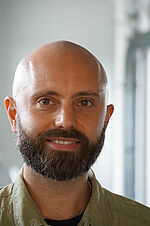
Group leader: Stem Cell Metabolism
University Children’s Hospital
Heinrich-Heine-University
Moorenstraße 5 40225 Düsseldorf
Scientific focus
The group of Alessandro Prigione bridges two different research areas: i) human induced pluripotent stem cells (iPSCs)-based neuronal disease modeling, and ii) mitochondrial metabolism. The focus is to dissect the mechanisms underlying the neuronal pathology caused by mitochondrial disorders and to investigate the importance of mitochondrial impairment in early-onset neurodegeneration.
In our lab, we use patient-derived iPSCs to generate neuronal/glial cells and cerebral organoids carrying patient-specific mutations within nuclear DNA or mitochondrial DNA. With these model systems, we can begin to dissect how mutations affecting mitochondrial function can trigger neuronal pathology. In particular, we have a primary focus on Leigh syndrome, which is the most severe form of mitochondrial disease in children.
Our goal is not only to advance the mechanistic understanding of diseases, but also to discover potential treatments. After having identified mutation-specific cellular phenotypes in our iPSC-derived neuronal models, we carry out high-throughput screenings to possibly identify therapeutic compounds.
We integrate stem cell technology, neuronal and glial differentiation in 2D and 3D (cerebral organoids), CRISPR/Cas9-based genome engineering, and mitochondrial-specific assays with high-content analysis (HCA) and compound screenings centered on mitochondrial and neuronal function.
Specific Projects
- iPSC-based modeling of Leigh syndrome (BMBF eBio project)
- Mechanistic dissection of the mitochondrial impairment occurring in early-onset Huntington’s disease (DFG project)
- Mitochondrial and metabolic coupling in human neurons and astrocytes
- High-content analysis (HCA) and compound screenings for mitochondrial neuronal toxicity
Further information
Selected Publications
- Brunetti D, Dykstra W, Le S, Zink A, and Prigione A. Mitochondria in neurogenesis: implications for mitochondrial diseases. Stem Cells, 2021 Oct;39(10):1289-1297. PubMed
- Le S, Petersilie L, Inak G, Menacho-Pando C, Kafitz KW, Rybak-Wolf A, Rajewsky N, Rose CR, Prigione A. Generation of Human Brain Organoids for Mitochondrial Disease Modeling. JoVE, 2021 Jun 21;(172), doi: 10.3791/62756. PubMed
- Inak G, Rybak-Wolf A, Lisowski P, Pentimalli TM, Jüttner R, Glažar P, Uppal K, Bottani E, Brunetti D, Secker C, Zink A, Meierhofer D, Henke MT, Dey M, Ciptasari U, Mlody B, Hahn T, Berruezo-Llacuna M, Karaiskos N, Di Virgilio M, Mayr JA, Wortmann SB, Priller J, Gotthardt M, Jones DP, Mayatepek E, Stenzel W, Diecke S, Kühn R, Wanker EE, Rajewsky N, Schuelke M, Prigione A. Defective metabolic programming impairs early neuronal morphogenesis in neural cultures and an organoid model of Leigh syndrome. Nat Commun. 2021 Mar 26;12(1):1929. doi: 10.1038/s41467-021-22117-z. PubMed
- Zink A, Conrad J, Telugu NS, Diecke S, Heinz A, Wanker EE, Priller J, and Prigione A. Assessment of ethanol-induced toxicity on iPSC-derived human neurons using a novel high-throughput mitochondrial neuronal health (MNH) assay. Front. Cell Dev. Biol. 2020 Oct 15; DOI: 10.3389/fcell.2020.590540. PubMed
- Cunnane SC1, Trushina E, Morland C, Prigione A, Casadesus G, Andrews ZB, Beal MF, Bergersen LH, Brinton RD, de la Monte S, Eckert A, Harvey JZ, Jeggo R, Jhamandas JH, Kann O, Mannoury la Cour C, Martin WF, Mithieux G, Moreira PI, Murphy MP, Nave KA, Nuriel T, Oliet SHR, Saudou F, Mattson MP, Swerdlow RH, Millan MJ. Brain energy rescue: an emerging concept for new therapeutics in neurodegenerative disorders of aging. Nat Rev Drug Disc 2020 Sep;19(9):609-633. PubMed
- Scior A, Arnsburg K, Iburg M, Juenemann K, Pigazzini ML, Mlody B, Puchkov D, Ast A, Buntru A, Priller J, Wanker EE, Prigione A, Kirstein J. Complete suppression of Htt fibrilization and disaggregation of Htt fibrils by a trimeric chaperone complex. EMBO J. 2018 Jan 17;37(2):282-299. PubMed
- Lorenz C, Lesimple P, Bukowiecki R, Zink A, Inak G, Mlody B, Singh M, Semtner M, Mah N, Leong M, Auré K, Pfiffer V, Fauler B, Eichhorst J, Lyras EM, Wiesner B, Priller J, Huebner N, Mielke T, Meierhofer D, Izsvák Z, Meier JC, Bouillaud F, Adjaye J, Wanker E, Schuelke M, Lombès A, Prigione A. Human iPSC-derived neural progenitors are an effective drug discovery model for neurological mtDNA disorders. Cell Stem Cell. 2017, May 4;20(5):659-674. PubMed
- Mlody B, Prigione A. A Glycolytic Solution for Pluripotent Stem Cells. Cell Stem Cell. 2016, Oct 6;19(4):419-420. PubMed
- Wang J, Xie G, Singh M, Ghanbarian AT, Raskó T, Szvetnik A, Cai H, Besser D, Prigione A, Fuchs N, Schumann G, Chen W, Lorincz MC, Ivics Z, Hurst LD, Izsvák Z. Primate-specific endogenous retrovirus driven transcription defines naïve-like stem cells. Nature. 2014, Dec 18;516(7531):405-9. [IF: 42.3] PubMed
- Prigione A, Fauler B, Lurz R, Lehrach H, Adjaye J. The Senescence-Related Mitochondrial /Oxidative Stress Pathway is Repressed in Human Induced Pluripotent Stem Cells. Stem Cells. 2010 Apr;28(4):721-33. PubMed


